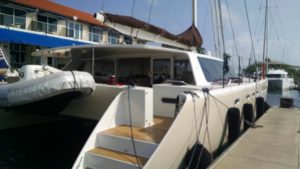“Dreams aren’t expensive, they’re priceless”
Last year, I had an incredible opportunity to going sailing through the Panama Canal and up the Pacific coast of Central America with family friends Jim and Laura. I chronicled it in several posts on this blog.
It was an amazing opportunity on so many levels. Who doesn’t love the chance to be on the ocean, see Mother Nature at her purest and most beautiful, stop in hidden paradises, and on and on?
On the trip I got the chance to learn the Jim-and-Laura story. It’s quite amazing (but maybe not—you’ll see what I mean at the end of this post). When they retired, they sold their condo and pretty much all their worldly possessions, bought a boat, and adopted the sailing lifestyle. They’ve been doing that for the past 10 years, and have never looked back. They are such an inspirational couple.
Whenever I share this story, or how the idea of sailing around the Caribbean or the world is really appealing to me, one question, sooner or later, always comes up: How could a normal person afford that?
Before you read on, ask yourself these two questions:
- How much does it cost to live on a yacht in the Caribbean, going from beautiful beach to beautiful beach, totally living the dream?
- Could I afford it?
Think of your answer and then read on to see if you’re right. Hint, I bet you are way high on #1 and I bet #2 is actually “yes”.
My time with Jim and Laura, as well as following a number of sailing blogs has taught me that living your sailing retirement dream really isn’t all that expensive. Sure, it’s easy to bring to mind an image of the mega-rich on their mega-yachts, and instantly dismiss the idea as out of reach.
Yet, I think this really illustrates how attainable this AND MOST RETIREMENT DREAMS ARE.
The cost of Jim and Laura’s sailing dream
Jim and Laura (“J&L” from now on) were very open regarding their expenses, which I really appreciated because it gave me some real insights into this. They were even more open to allow me to post this on my blog—so Thank you Jim and Laura.
The first thing you need is a boat. J&L got a used 36-foot yacht for about $90,000 then they put about $2,000 in to it for upgrades and repairs. It has a kitchen, bathroom, and two bedrooms. When it was all said and done, they spent $92,000 on their boat. That’s really the only major purchase you need to make. Everything else is just living expenses.
Living the boating lifestyle is amazingly affordable. About half the time they “park” their boat at an anchorage (literally, drop their anchor near a beach and just hang out there). These are usually free. Other times, they dock in a marina. Marinas cost money and can vary widely based on the amenities they offer, but J&L said that $500 per month was a good baseline.
Maybe think of that as their housing expenses—a $92,000 down payment and then a $500 mortgage. For that they have the best backyard in the world (the ocean and beaches). Depending on your tastes, maybe it’s a bit small, but more on this in a second. All in all, that seems like a screaming deal.
A sailor doesn’t survive on shelter alone. There’s that other expense called . . . food. J&L’s experience is that groceries tend to cost fairly similar amounts in the US and the places in the Caribbean they visited (about 10 or so countries, so they did get a fairly diverse perspective). Let’s call that a wash to slightly favorable for J&L.
The other component of food—dining out—tends to be a fairly important component in retirement. Data shows that people go out to eat a lot in their 50s and 60s and 70s. This is one of the places where the sailing lifestyle really pays off. Nearly all the places where people would anchor or dock have restaurants on the beach that appeal to the tourist set. These places tend to be inexpensive compared to US standards. When I was sailing and we went out to dinner, I consistently got really good meals (mostly seafood, but not always) that in the US would cost $30-40 and they would cost about $10-15. J&L said that was fairly common.
Healthcare is another big expense that we all think about, especially in our later years. A huge benefit about living in those Caribbean countries is that healthcare is very affordable. Standard check-ups and prescriptions cost pennies on the dollar compared to US prices. More complex procedures (Laura had a small surgical procedure), almost all dental work, and stuff like laser eye surgery are similarly cheap. Fortunately, J&L didn’t have personal experience with more complex and uber-expensive stuff (cancer diagnosis, pacemaker, artificial joint, etc.), so it’s hard to say on those. But the majority of healthcare expenses that we’re most likely to have are much, much less expensive that would be in the US.
Many common expenses like clothes and entertainment are a lot less. With clothes, the wardrobe for a sailor is much simpler (bathing suits, shorts, and t-shirts plus a Hawaiian shirt for special occasions). For entertainment, they still go to movies, see the sights like amusement parks and zoos, and things like that, but they are much less in the Caribbean.
Other common expenses are eliminated like car payments and other car expenses, cable (they just stream stuff on the internet and have Netflix), and property taxes.
Certainly there are expenses that they have which land-lovers don’t. Since they don’t have a car if they want to go somewhere that usually requires a taxi, but those tend to be cheap (it cost me $100 to take a taxi completely across the entire country of Panama). Also, there is boat maintenance. The salt water is incredibly corrosive so that causes a lot of damage. In Jim’s words “there is always something that needs to be fixed.” This can be the $50 variety or the $500 variety and on up. Probably once a year they take the boat completely out of the water and check everything out. All said, Jim estimates they spend about $2,500 per year on boat repairs.
Plus, there are boat-specific expenses like boat insurance and weather reports. They also take trips back home to see family, and other stuff like that. But those don’t tend to be big line items.
As expensive as you want to be
Most people are surprised when I share these stories about sailing. The image tends to be scenes from Lifestyles of the Rich and Famous showing mega-yachts with people with large sunglasses and white leisure suits sipping on champagne poured by servants.
Certainly that’s there. In a marina we were at in Panama, 98% of the boats were like J&L’s. But the boat that got the most attention was a 75-foot catamaran. At dinner with the other sailors we would speculate that it probably cost $5-7 million. Maybe they were drinking champagne (I never got close enough to be able to tell), but we were drinking local beers that cost $5 for a bucket of six.

You could apply this concept to everything. If you wanted to go to super nice restaurants every day you could and it would cost more. But J&L and the vast majority of people doing what they were doing would go to a nice restaurant every once in a while, but most of the time went to nice but affordable places.
For J&L, they probably wish their boat was a bit bigger. At 36-feet, it’s a bit cramped. When I visited, there was certainly room for all of us, but it was cozy. They could get a 40- or 45-foot boat and maybe even go with a catamaran. That would give them more room, but of course those things cost more.
It seems true with boats as with most luxury things (ski condos, Manhattan apartments, beach houses), that the nicer, bigger, more complex you get, costs go up in a hurry. For J&L, they could still probably go a little nicer/bigger and stay at a reasonable costs, but looking at that 75-foot catamaran as an example, it’s easy to let costs explode.
The reason I think this is so important is because for so many people retirement expenses loom like some kind of enormous monster. Sure, they’re there, but probably not as bad as you think. Certainly, you have a lot of control over how mean and big and scary that “retirement expense monster” is going to be.
This seems particularly true with an example of retiring and sailing around the Caribbean. Just at first glance it sounds prohibitively expensive. I wonder how many people give up that race before they even try.
Sailing is the example I used because I am most familiar with it, and it’s nearest to my heart, but I think you could tell a similar story with a beach retirement or skiing, or traveling. All those can be super expensive if you throw caution to the wind and spend, spend, spend. However, if you take a more moderate approach I think you’ll be amazed at what you can afford and how achievable your dream retirement can be.
As you might expect, I was very curious about all this and spent a lot of time talking to Jim about this. At the end of the day, Jim threw out a number saying, “All in, you could live like a king on $3,000 a month.” Yowza. I hope that makes you sleep better dreaming about living on a beach.
Now that we’re at the end of this post, what were your answers to those two questions when you first started reading?

This really opens the door to lots of interesting possibilities for retirement living. It shows that with a little planning, there are so many other ways to enjoy life besides a retirement home. You have a real talent for thinking outside the box, Stocky!
Great article, definitely makes you think about the possibility of other lifestyles and retirement. Thanks for sharing.
I think my husband’s parents found it quite a bit more expensive, but it all depends on what kind of accommodation you’re looking for, where you’re sailing and when, etc. etc. But I do think it can be affordable and your blog is insightful on that point.